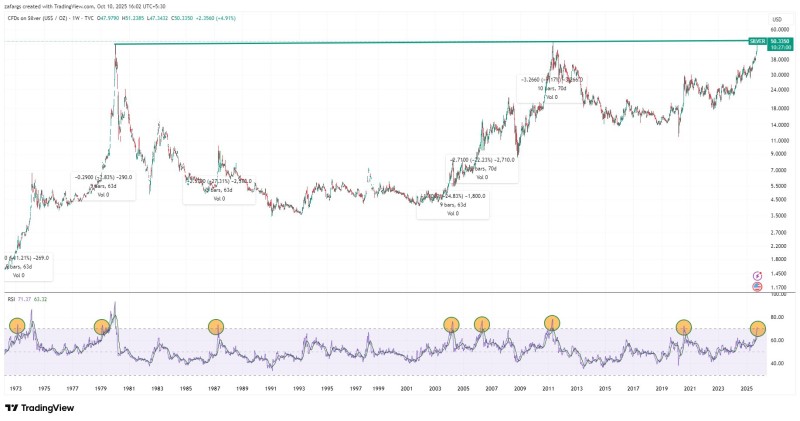Silver has climbed back to a price level it hasn't held for long in decades. The metal is now testing $50 per ounce—a zone that has historically marked turning points.
What Investors Can Do
According to Zafar Shaikh, there's a pattern worth watching: when silver's weekly RSI pushes above 70, a pullback typically follows within 10 weeks. With the RSI currently in that territory, both short-term traders and long-term holders should pay attention.

The chart tells a familiar story. Silver hit $50 twice before—in 1980 and again in 2011—and both times it reversed hard. The weekly RSI sitting above 70 confirms what many traders already suspect: the market's gotten ahead of itself. Past peaks at this level have been followed by corrections over the next couple of months. Silver tends to whipsaw violently near these highs, and this time looks no different. Still, the fundamentals remain solid. Inflation fears, strong industrial demand from solar panels and electronics, and investors seeking safety all support the current move.
- Dollar-cost averaging: If you're not sure whether to jump in now, consider spreading purchases over the next few months. Buying a little each week smooths out the volatility and reduces the sting if prices dip.
- Wait it out: History suggests a correction could arrive by year-end, giving patient investors a better entry point.
- Think long-term: Short-term wobbles aside, silver's outlook remains strong. It's both an industrial workhorse and a hedge against uncertainty—a rare combination.
Bottom Line
Silver's sitting at a crossroads. A breakout above $50 could ignite a fresh leg higher, but the overbought signals suggest caution in the near term. For investors, the real question isn't whether silver will rise eventually—it's whether buying at resistance is worth the risk, or if waiting for a pullback makes more sense.
 Saad Ullah
Saad Ullah

 Saad Ullah
Saad Ullah


